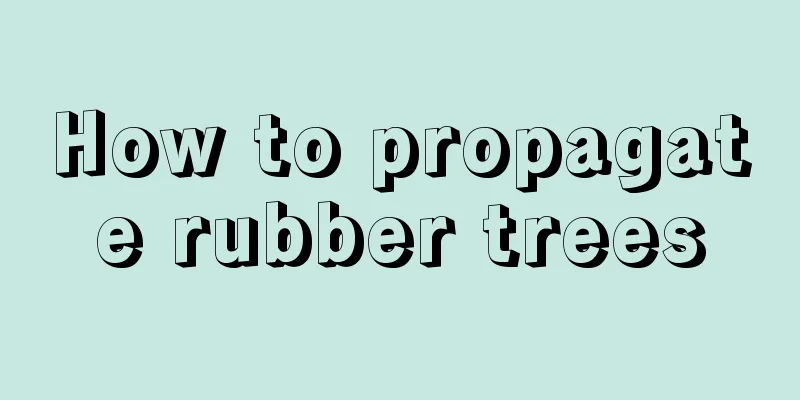How to propagate rubber trees

1. Leaf cuttingsThis method is best used when the temperature is above 20 degrees Celsius, but the temperature cannot be too high, and it is best not to exceed 32 degrees. When choosing leaves, you should follow the principle of being healthy, strong and free of pests. It is best to have a thicker base. When cutting the leaves, you should cut them off together with the petiole. It is best to disinfect the wound after cutting it. Different substrates can be selected for leaf cuttings. Commonly used ones are river sand or perlite. Of course, you can also use hydroponic methods to cultivate roots. After the roots grow to 3 to 5 cm, they can be moved into a pot. If you want to grow it hydroponically, it is worth noting that you should prepare clean water in advance or let the water dry for a few days, then soak the petiole in the water for about 5 cm. It is okay if the leaves do not touch the water. Before it takes root, change the water every 3 to 5 days to ensure the activity of the water. If you want to use soil for cuttings, the choice of soil is very important. It is best to choose sandy soil and insert the cut leaves obliquely into the soil, about 3 cm. During the period, make sure the soil is moist enough, and then put it in a cool place to ensure unobstructed air circulation and avoid exposure to sunlight. 2. Branch cuttingsFirst, choose cuttings, generally choose thick branches, preferably semi-lignified ones. Cut the branches, each piece is about 12 to 15 cm long, then burn the wound with fire and wait until the white liquid stops flowing out. Cut off the leaves, insert the branches into water, and place them in a well-lit place. It is best to sprinkle water about 3 times a day, change the water every 2 to 4 days, and roots will grow in a little more than a week. When the roots grow to 3 to 5 cm, you can move it into a pot. It will grow permanent roots in about half a month. At this time, you can gradually expose it to the sun and new leaves will soon grow. |
<<: How to propagate copper coin grass
Recommend
Euonymus cultivation method
Euonymus cultivation method soil Euonymus has str...
Sweet potato cultivation time and method
Sweet potato , also known as sweet potato, sweet ...
When is the best time to sow dahlia seeds?
Dahlia seed sowing time Dahlia seeds are generall...
How to grow mango, mango pictures
1. How to grow mango 1. Potting soil selection: T...
If there is no stuff in the pot, the flowers and plants will die!
Clay effect: The gaps between ceramsite particles...
Cultivation methods and precautions of boxwood bonsai
The boxwood bonsai plant is very easy to grow. As...
Is Asparagus fern suitable for large or small pots?
Should I use a large or small pot for asparagus f...
The efficacy and function of dog liver vegetable
1. Efficacy and Function Dog liver vegetable has ...
Can the hibiscus survive if its leaves wilt?
1. Can I still live? Hibiscus is a beautiful flow...
How to prune hibiscus
How to prune hibiscus branches and leaves Because...
The efficacy and function of Cattleya
The role of Cattleya Enjoy the flowers and leaves...
Is Begonia suitable for growing at home?
1. Is it suitable? If the cultivated variety of c...
The efficacy and function of Dianthus superbus
Medicinal value of Dianthus superbus In fact, I p...
Should I use a deep or shallow pot for Amaryllis?
1. Use a deep or shallow basin When planting amar...
Can broad bean husks be used as fertilizer?
Broad bean skins as fertilizer Broad bean skins c...









